The market for analytics tools is scattered. 100+ web analytics companies want to dethrone Google Analytics. Some focus on more tracking and insights, whereas others, like Simple Analytics, focus more on privacy. Of all the analytics tools, Plausible is closest to Simple Analytics.
At Simple Analytics, we often get the question of how we are different from Google Analytics, but the real privacy enthusiast asks us how we are different from Plausible. This is way more nuanced as both solutions have a similar approach.
In this article, we’ll find out what those differences look like.
Let's dive in!
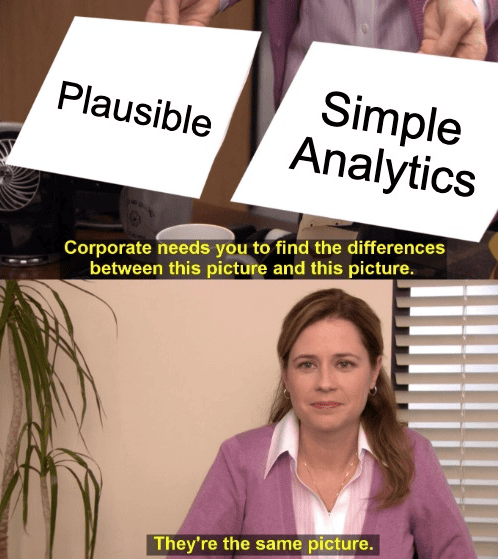 No they are not
No they are not
- Data Insights
- Privacy: Privacy-friendly vs. Privacy-first
- Data interoperability
- User Experience & features
- Costs
- Why do we care
Data Insights
The extensiveness of data insights is always interlinked with privacy-friendliness. The more data insights are provided on the individual level, the less privacy-friendly it is usually.
Google Analytics is the most complex and data-rich analytics tool, because it does not care about your privacy. It collects personal data and installs trackers in your browser. The more they know about you, the more they earn. Google Analytics is ultimately incentivized to exploit your personal data.
Simple Analytics and Plausible differ from Google in this approach. Both value privacy over individual tracking and collecting personal data. However, there are varying degrees between them.
Simple Analytics does not collect any personal data or use cookies at all. Therefore, it is impossible to collect session data on individual users. Simple Analytics is built with a privacy-first approach from the ground up. All the metrics in the dashboard are based on non-personal data.
Non-personal data and being cookieless by design do not necessarily mean the data is flawed or inaccurate. You can still see and track all your metrics.
Plausible takes a similar approach. However, the most significant difference is that Plausible collects data differently. They can show data insights on the individual level because they do collect and store personal data. Plausible collects hashes of IP addresses and stores them for 24 hours. This means they ‘anonymize’ the IP address to track an individual user for a day.
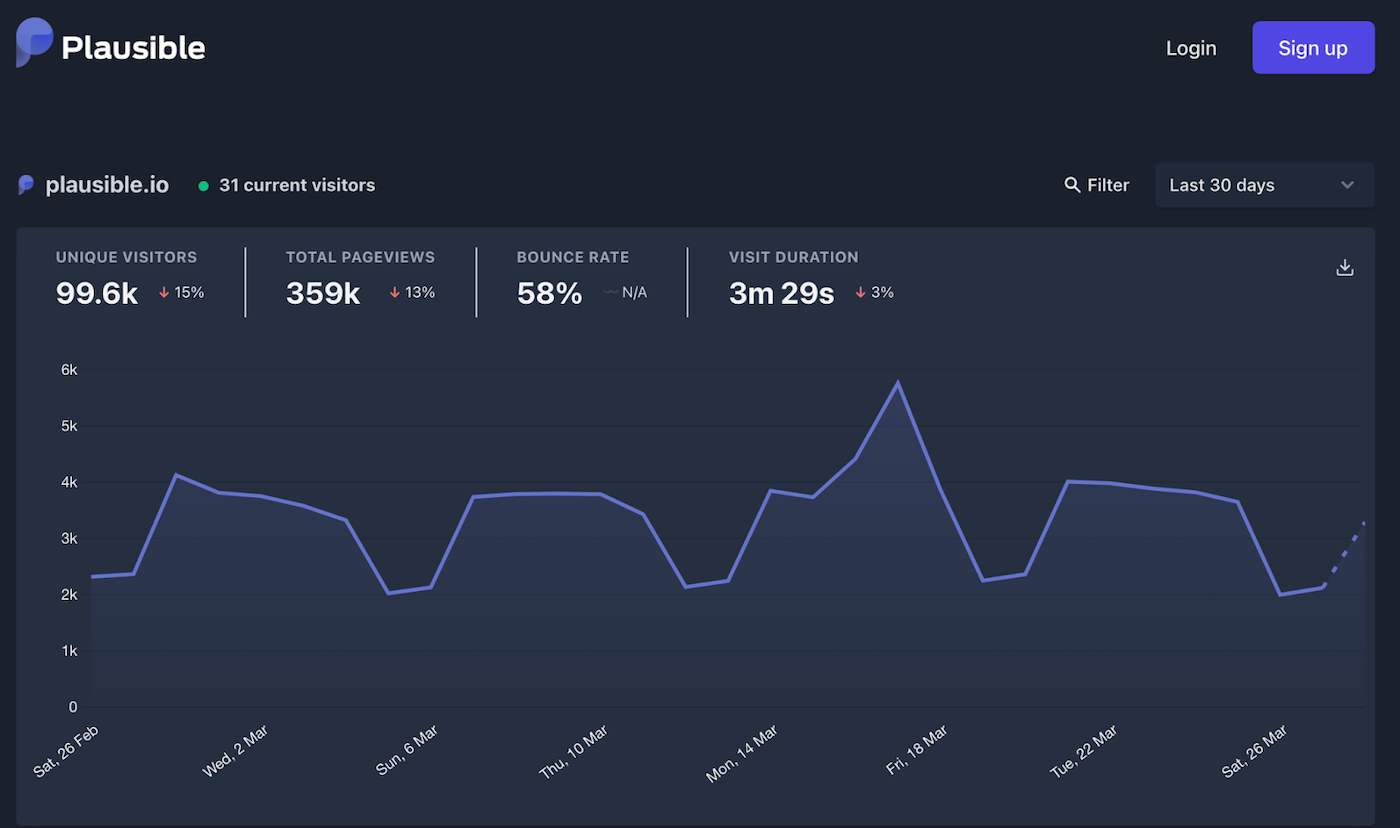 Plausible dashboard
Plausible dashboard
Plausible uses the same method for time on page as Google. We calculate it differently. We analyzed how Google Analytics does it and concluded that this method needs to be more accurate.
- Google Analytics doesn’t record the time on page if the visitor only visits one page.
- Google Analytics doesn’t record the time on page of the last page visited
- Google Analytics records time on page if you leave a tab open but are “spending time” in a different tab.
In addition, Google Analytics includes bounced visitors, but their time on page is set to 10 seconds by default.
Plausible excludes bounced visitors entirely from the calculation. It, therefore, shows a higher than actual number on average time on page.
At Simple, we detect when a visitor navigates to a different website. We record the time on page for a bounced visitor and the time on page for the last visited page. To filter out outliers, we use the median instead of the mean to get to the most accurate number.
Privacy: Privacy-friendly vs. Privacy-first
Without a doubt, Simple Analytics and Plausible are both companies that value privacy and share a common belief in making the Internet a safer place. However, the degree varies. This is perfectly illustrated on both home pages.
- Simple Analytics: Privacy-first
- Plausible: Privacy-friendly
Plausible also mentions this in their data policy:"Plausible attempts to strike a reasonable balance between de-duplicating page views and staying respectful of visitor privacy."
Simple Analytics states: "We never collect IP addresses or any form of personal data."
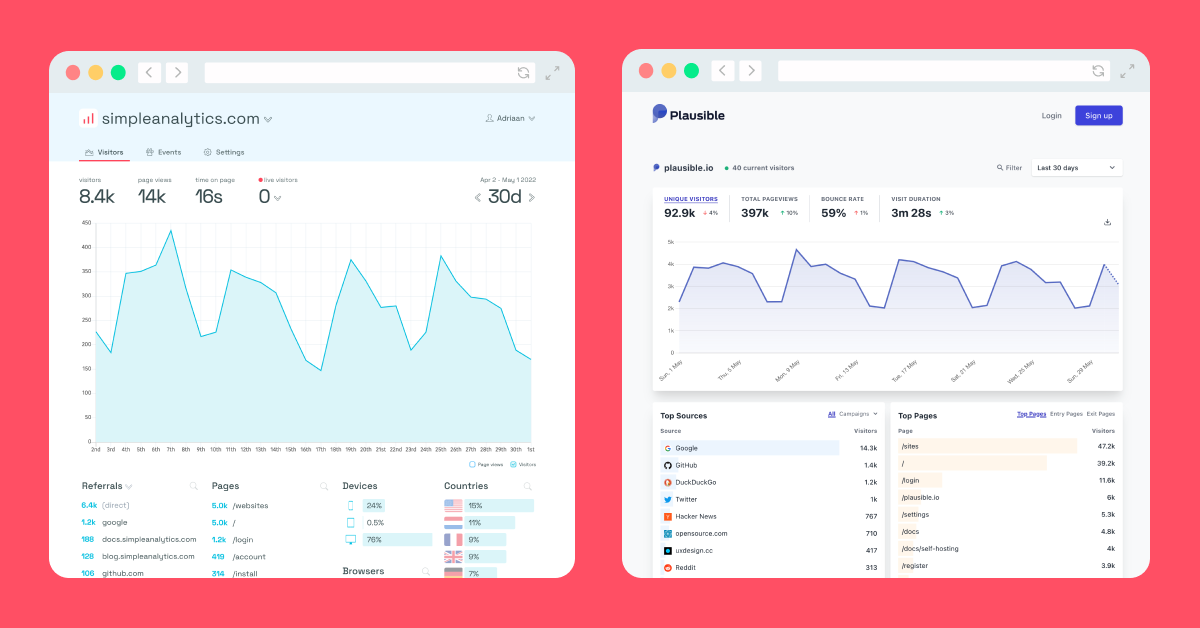 The dashboards of Simple Analytics and Plausible.
The dashboards of Simple Analytics and Plausible.
Are IP hashes considered personal data?
IP hashing means transforming an IP address into an unrecognizable string of numbers. It’s a technique to track an individual’s behavior without directly collecting and storing the IP address.
IP hashing is more privacy-friendly, and Plausible collects the IP hashes for 24 hours. However, we consider this fingerprinting, and we believe this falls under tracking in the GDPR, for which you would need consent.
Something can be considered fingerprinting if it is possible to single out a specific visitor by combining information such as pixel density, device identifier, default language, and timezone. A hash of IP basically does the same. It singles out an individual user. This conflicts with GDPR.
Article 4 of the GDPR states that personal data relates to any information relating to an identified or identifiable natural person (‘data subject’). In addition, different kinds of identifiers are mentioned. It doesn’t describe any specific technologies, such as fingerprinting, but one could interpret this from the statement.
This is a grey area, to say the least, and we want to stay away from those. We believe you can provide actionable insights without collecting personal data. It’s not our goal to just comply with GDPR law but to protect the privacy of internet users regardless.
Data interoperability
There are many ways to get your data out of Simple Analytics. We believe this is our duty as the data we collect is yours, so you should do whatever you want with it. The information Google Analytics collects, for example, is theirs. That’s why Google Analytics is free. You pay with your data.
Simple Analytics makes it easy to connect your dashboarding tools. For example, you might want to build your own reports and move your data to a data lake (like Snowflake). We offer many APIs, including raw-level data.
It’s also very easy to get your data in. Users who want to switch to Simple Analytics can import Google Analytics data. You won’t have to deal with the loss of historical data.
A lot of the above is also possible in Plausible. They recently added the feature to import Google Analytics data as well. In addition, Plausible also provides different APIs to connect your data with dashboarding tools. However, the APIs are only limited to aggregate data.
Simple Analytics offers both aggregated data as well as raw data. We believe raw data is important to analyze your data. You don't want aggregated data when combined with other data sources.
 The battle between Simple Analytics vs. Plausible.
The battle between Simple Analytics vs. Plausible.
User Experience & features
At first hand, Simple Analytics and Plausible look similar. Both have built a one-page dashboard that provides the most valuable website metrics at a glance. Whereas Google Analytics shows you 75 reports when opening the dashboard.
Everything in our dashboards is clickable, and it’s very easy to segment and see which pages are performing better than others.
Lightweight script
Both Simple Analytics (3kb) and Plausible (>1kb) are lightweight web analytics tools. Google Analytics, for example, uses a script that is 45kb. This significantly impacts the page load speed and, therefore, your user experience.
In addition, it might also have a positive impact on your search ranking. Last year, Google added a page experience update to their search result ranking. We tested the impact of adding a Google Analytics script to a website vs. adding the Simple Analytics script. Our results show that Google penalizes you for using Google Analytics. The difference in page load speed was ten basis points.
There is, however, still a difference between the scripts of Simple Analytics (3kb) and Plausible(>1kb). The impact is not as significant as with Google Analytics, but it is interesting to see the difference.
We don’t track our users, so we need to get more from the browser to provide the same website stats. For example, Plausible gets unique page views from tracking IP hashes for 24 hours. We get our unique page views from the referrer domain. This happens in the frontend, whereas tracking IP hashes happens in the backend. Therefore, our script needs to be bigger.
For lightweight enthusiasts, we do have a compressed version of the script (1.6kb).
Open source
Plausible is open-source, meaning their source code is publicly available. The data collection scripts of Simple Analytics are also open-source. They are available on GitHub
Mini websites & Twitter referral traffic
Simple Analytics is privacy-first but simple-second. It's probably the only analytics tool that transforms referral links into mini websites. They are referral links but visualized in a screenshot of the link page.
 Mini websites in Simple Analytics
Mini websites in Simple Analytics
Do you see those t.co referrals domains in Plausible or Google Analytics? We created a Twitter overview that shows you the exact tweets you got traffic from. Not with useless t.co links, but with useful and beautiful designed tweets.
Goals & Events
The biggest feature difference are in the Goals section & Events section. Plausible integrates both in the visitor dashboard; we created a standalone Goals dashboard & Events explorer.
The Events Explorer is a great way to get a quick overview of all events in Simple Analytics. It allows you to export data very quickly and only get the data you need. You can add columns; if a column has different values, it will be grouped by those values.
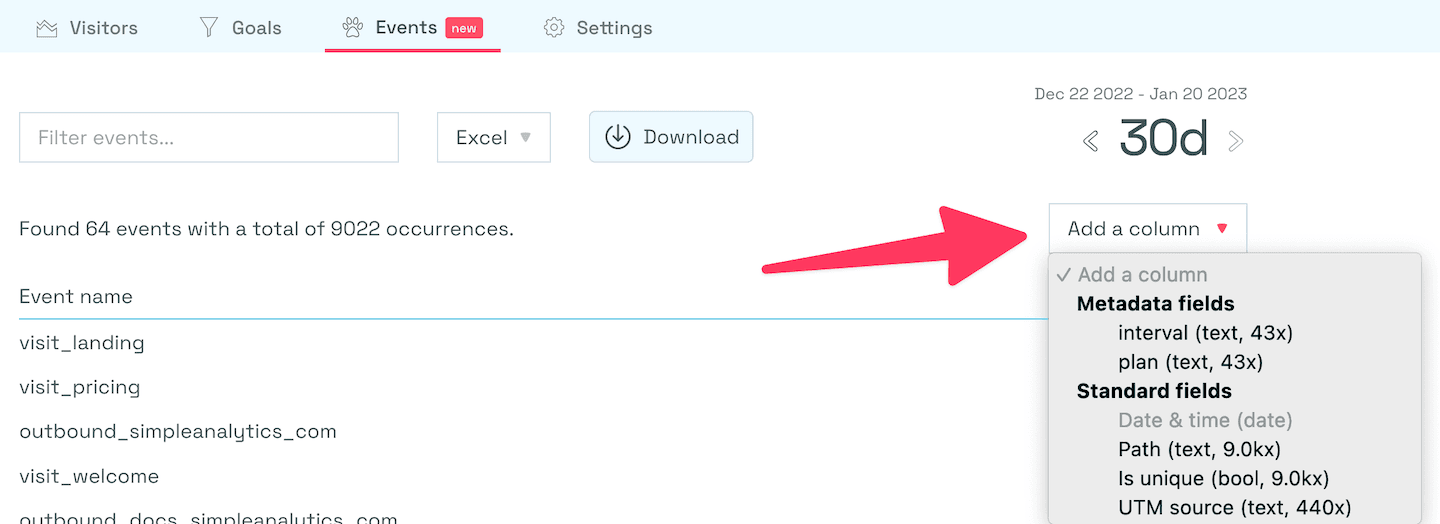
Our goals feature is really helpful for organizing and understanding your data. With it, you can set up filters for your data or create funnels based on events.
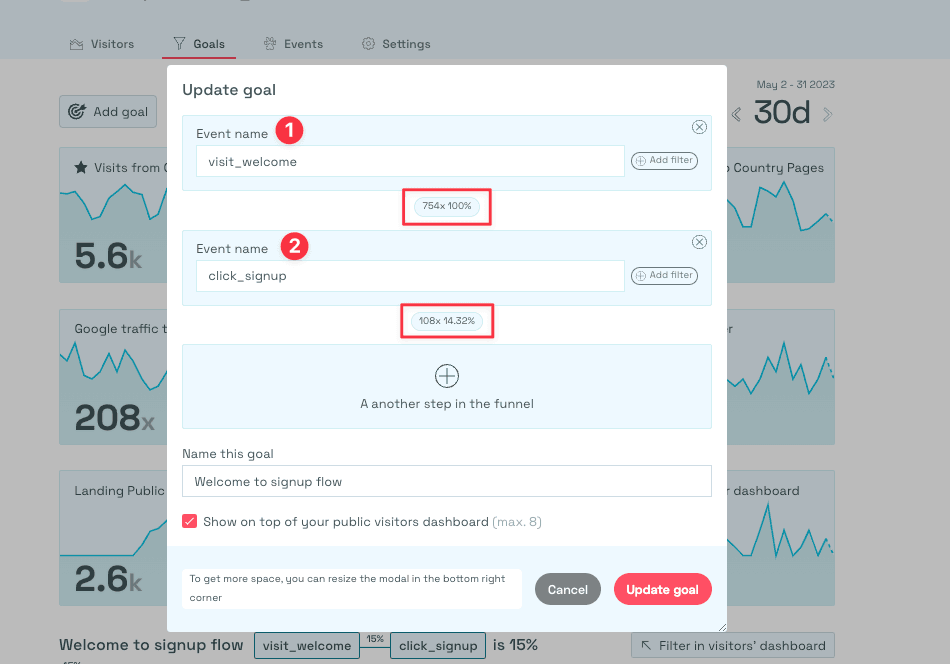
You can add multiple steps in the funnel and filter for specific characteristics such as “referrer” “path” and much more. Adding your most important KPIs to your visitor dashboard as a mini-dashboard is also possible.
By clicking the mini-dashboard like in the image below, you can immediately see how the KPI performs over time and see metrics like “time on page,” “browser type,” “country,” and whether users prefer mobile or desktop.
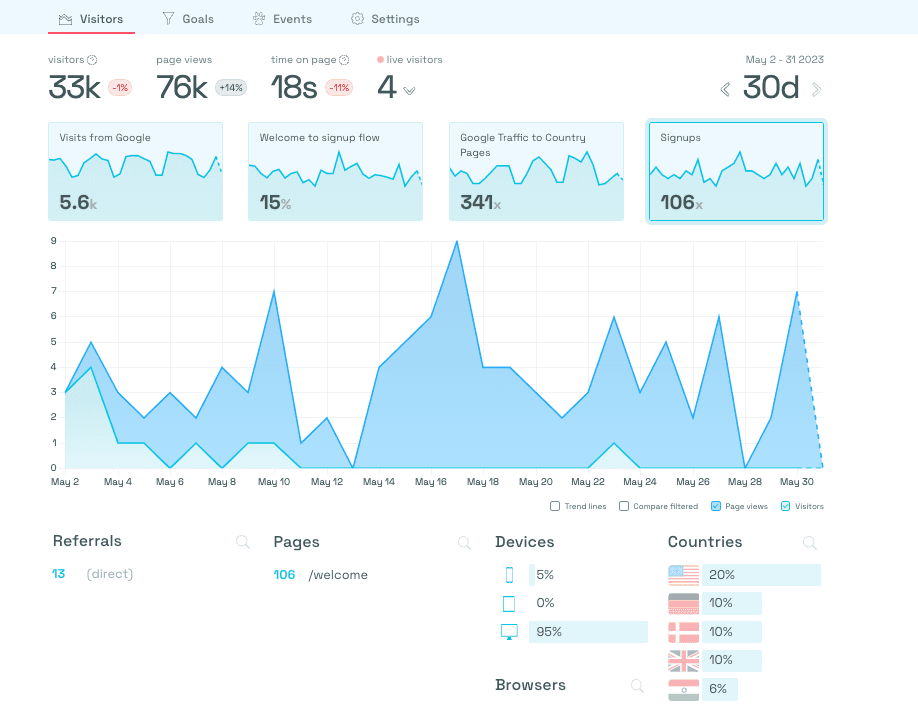
Costs
Plausible is open source. This means the source code is out there for anyone to host their analytics. However, you need to be technical, and you still need to pay for your own hosting and keep the software up to date.
These are the paid solutions Plausible offers (based on a yearly plan):
- 90$ Per year for up to 10,000 pageviews.
- 190$ Per year for up to 100,000 pageviews
- 690$ Per year for up to 1 million pageviews
Simple Analytics is not open source and only has paid options (based on a yearly plan)
- Starter Plan: 108$ for up to 100,000 page views per year.
- Business plan: 588$ for up to 1 million page views per year.
We value long-term customers. Hence we give a huge discount to customers on a yearly plan.
Why do we care
Adriaan started Simple Analytics four years ago to make the internet safer and provide an alternative to data-devouring machines like Google. We genuinely believe you can get actionable insights without using personal data or tracking mechanisms.
We built Simple Analytics not only for companies that want to comply with GDPR law but for organizations that care about their visitors. By supporting us in our mission, you are not only preserving your visitor’s privacy but also supporting a small independent team. Feel free to give us a try
